

MAKESHIFT // CATALOGUE // SERVER. Server from Alastair Parvin on Vimeo.
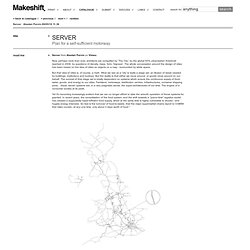
Now, perhaps more than ever, architects are compelled by 'The City'; by the global 50% urbanisation threshold reached in 2008, by questions of density, mass, form, 'bigness'. The whole conversation around the design of cities has been based on the idea of cities as objects on a map - surrounded by white space. But that view of cities is, of course, a myth. What we see as a 'city' is really a stage set: an illusion of stasis created by buildings, institutions and routines. But the reality is that either we move around, or goods move around on our behalf. Yet it's becoming increasingly evident that we can no longer afford to take the smooth operation of those systems for granted. Map of the UK Strategic Road Network Showing the location of the RDC's (Regional Distribution Centres) of the 'big three': Sainsbury, Tesco and Asda Wal-Mart.
Bodega Algae LLC / Efficient Scalable Algae Photobioreactors. AlgaeGeek.com. This project is an easy to use platform for one technique that is broadly being used with to trick the algae into reproducing.
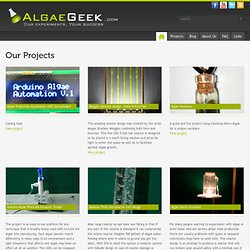
Each algae species reacts differently in many ways to its environment and a light frequency that affects one algae may have no effect at all on another. How to Make algae - search Instructables. Bio-ceramics allow algae to live on. Algae Photobioreactor, Teaching Modules, University of Utah, Chemical Engineering. ← return to all modules Anthony Butterfield | Created: January 12, 2011 | Last Modified: October 18, 2013 Summary: The Rubens' Tube, named after 19th century physicist Heinrich Rubens, is a fairly common but striking demonstration of the propagation of sound and the emergence of standing waves.

Heights of the flames flowing out of small holes in the top of the tube adjust to reflect the frequency and speed of sound. To the Chemical Engineer, the Rubens' Tube is also an interesting illustration of fluid dynamics and combustion processes. IMPORTANT!!! General Information: Essential Questions How do sound waves propagate and what is a standing wave? Bibliography Ficken, G.W., Stephenson, F.C., Rubens flame-tube demonstration. Materials & Methods. The other biofuel. Professor Yusuf Chisti.

Glasgow Sustainable Development Network. Biofuel Production From Algae There is a global need for inexpensive fuel production from renewable sources that either sink CO2 or are carbon neutral.
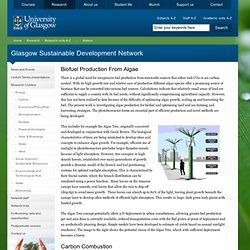
With its high growth rate and relative ease of production different algae species offer a promising source of biomass that can be converted into various fuel sources. Calculations indicate that relatively small areas of land are sufficient to supply a country with its fuel needs, without significantly compromising agricultural capacity. Biofuels From Algae Hold Potential, but Not Ready for Prime Time.
Joel Cuello has developed the patented Accordion photobioreactor design to grow algae under precisely controlled conditions.
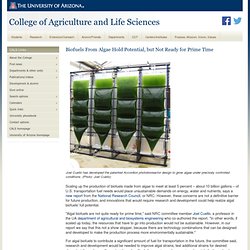
(Photo: Joel Cuello) Scaling up the production of biofuels made from algae to meet at least 5 percent – about 10 billion gallons – of U.S. transportation fuel needs would place unsustainable demands on energy, water and nutrients, says a new report from the National Research Council, or NRC. However, these concerns are not a definitive barrier for future production, and innovations that would require research and development could help realize algal biofuels' full potential.
"Algal biofuels are not quite ready for prime time," said NRC committee member Joel Cuello, a professor in the UA department of agricultural and biosystems engineering who co-authored the report. "In other words, if scaled up today, the resources that have to go into production would not be sustainable.
Read the rest of this November 1 UANews article at the link below. Date released: Photobioreactor. Modular Algae Photo-bioreactor. Algae production wall The purpose of this wall is to design as an interactive system which allows the general public to understand the production cycle of algae.
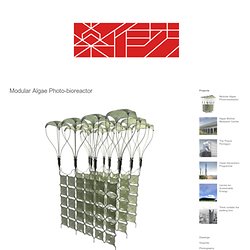
Built in a series of parallel walls, the suspending algae modular system could be constructed below any long span open structure frame. As visitors talking journeys between the walls in their different production cycle, they will begin to understand how algae photo-bioreactor works and their application toward zero carbon bio-fuel. Drawings. Selected design journals.
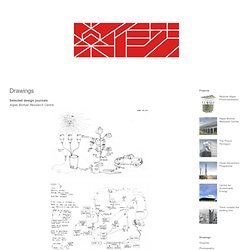
READER TIP: PhotoBioReactor Sculpture by BIOS. BIOS Design Collective is a working group of academic and professional designers “exploring the application of biological patterns to architecture.”

The latest project to pull natural science into the built environment is the PhotoBioReactor Sculpture by Charles Lee. Part sculpture, part renewable fuel factory and part bio-remediation plant, the design brings artistic, yet functional, forms into the landscape to inspire the imagination. A photobioreactor is a closed or semi-closed system in which light and nutrients are supplied to the system in an attempt to maximize algal biomass. Nutrients can be in the form of pollutants, so the sculpture can facilitate bio-remediation. It can also use CO2, reducing greenhouse gases.The algae can than be used to generate biodiesel. These photobioreactors are designed in a sculptural manner to add an eye catching feature to the park setting.
Furniture, Architecture, Gadget, Industrial Design - Syahdiar Daily Picks Design. Perth PhotoBioreactor uses Algae to Generate Fuel. The Perth PhotoBioReactor by Emergent Architecture will be made out of fiber-composite monocoque construction, pleated for stiffness and contains colonies of algae that require CO2 and light to generate biofuel.
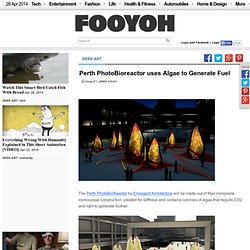
This system allows continued operation in shade and also in complete darkness through the use of a helix of lights inside each algae coil. The electricity needed is generated by thin-film solar transistors that are embedded in the transparent polycarbonate apertures and will be placed as a piece of art which helps generate fuel for the masses. Source: Eco Friend.
Flotspotting: Bio-Grow by Mark Schnitzer & Co. Posted by Ray | 18 Nov 2011 | Comments (1) We've got an oldie-but-goodie today: it's an upcycled photobioreactor for cultivating algae, which (ideally) could be exchanged for biofuel credits. But that's only half of the story: "Bio-Grow" took second place in the International E-Waste Design Competition 2010, incorporating refurbished waste materials—namely a laptop, an iMac and a tower enclosure—into the unassuming, bathroom sink-sized unit. Thus, Mark Schnitzer and his teammates Timothy Harvey, Elliot DeVries, Reza Shiftehfar and Meg Kenney designed "Bio-Grow" to hit the sweet spot between forward-looking sustainability and repurposing e-waste materials. Rising oil prices and overflowing dumps are ongoing problems... Can we solve for a 'green' issue while utilizing recycled electronic materials?